The population of Australia in June 2021 reached over 25 million, with over 80% of people living in the major cities. The services Australians access range from housing, education, healthcare and an infrastructure that is carefully planned. In order to contribute effectively to the Australian economy, people need quick and easy access to a number of amenities and services and properly planned urban development.
The flip side of poor urban planning can be seen in areas which suffer from unaffordable housing, where traffic congestion is common and infrastructure is inadequate. Town planning is often not something that individuals consciously think about until they come up against problems when developing or renovating their own property. At this time, the advice of professional town planning consultants is often required.
Types of Urban Planning
Understanding the different concepts of town planning helps when it comes to discussing what sort of support and advice you need for your own project with a local urban planning service. Listed below are some of the common types of urban planning.
Land Use Planning
Land use planning is the process of regulating the use of land by a central authority. This involves dealing with the policy and legislation around urban planning, involving the zoning or reserving of land for particular purposes. Land planning is usually divided into the following areas:
- Commercial areas for office buildings and retail parks for example
- Residential areas for housing
- Industrial areas for warehousing and manufacturing plants
- Municipal areas for structures like police stations and courthouses
Infrastructure Planning
Infrastructure planning involves the provision of physical facilities that serves a community and plans for their operation and management. Infrastructure planning covers areas such as safety and transport, public works and community infrastructure. Planning for community infrastructure is an important part of the land use planning process for areas experiencing growth. It ensures high-quality outcomes for growing communities and helps to make sure that community facilities and services meet the requirements.

Environmental Planning
Environmental planning facilitates decision making to carry out land development with the consideration given to the natural environment to achieve sustainable outcomes. This will include whether the build or redevelopment will impact on natural vegetation, impact on the air quality of the area (if an industrial or commercial build is mooted) and affects noise pollution (increased vehicle traffic or noise from machinery). This sort of urban planning also considers flood zones and impact on the habitats of endangered species as well.
Master Planning
Master planning involves the consideration of the future state for the land and what is needed to achieve the vision of that future use. Developers have to submit a land use plan including what infrastructure is required. If looking to build a new housing estate, then other amenities are considered such as outdoor recreational areas, space for medical centres and schools and the transportation needed to access this development. Projects on this scale cannot be achieved without the expert advice of urban planning services that will use local knowledge and experience to help bring a large-scale plan together.
Urban Revitalisation
Urban revitalisation is often used to address urban decay in cities and looks to regenerate areas or carry out improvements to buildings or homes that have fallen into disrepair. Rebuilding or reopening of roads or access ways, cleaning up of hazardous waste and pollution as well as liaising with the current community who live and work in the area, is where the town planners can support to revitalise a neighbourhood.
Whatever rebuilding or development project you have in mind, ensure to talk to urban planning experts to support the project through to a successful completion.

